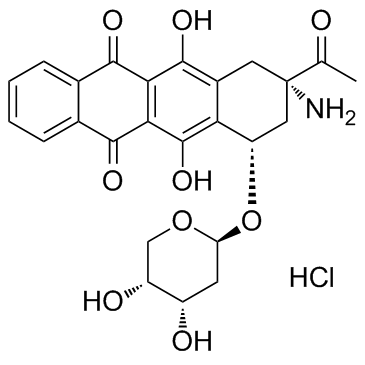| Description |
Amrubicin hydrochloride is a DNA topoisomerase II inhibitor, used for the research of cancer.
|
| Related Catalog |
|
| Target |
Topoisomerase II
|
| In Vitro |
Amrubicin hydrochloride is a DNA topoisomerase II inhibitor. Amrubicin (2.5 μg/mL) shows radio-enhancement effects on human lung adenocarcinoma A549 cells[1]. Amrubicin supresses the LX-1, A549, A431, and BT-474 cell lines, with IC50s of 1.1 ± 0.2, 2.4 ± 0.8, 0.61 ± 0.10 and 3.0 ± 0.3 µg/mL, respectively[2]. Amrubicin inhibits the cell cycle profile of U937 cells with an IC50 of 5.6 µM. Amrubicin (20 µM) also induces apoptosis in U937 cells, activates caspase-3/7 and reduces the mitochondrial membrane potential (Δψm)[3].
|
| In Vivo |
Amrubicin (25 mg/kg, i.v.) exhibits significant antitumor activities against both SCLC tumors, Lu-24 and Lu-134, with T/C-values (comparing the mean tumor growth rates of the treated group with those of the control group for each day that the tumors are measured) at day 14 of 17% and 9%, respectively. Amrubicin (25 mg/kg, i.v.) in combination with cisplatin and irinotecan significantly inhibits the growth of tumors compared to amrubicin alone in mice bearing LX-1 tumor cells. Amrubicin alone or combined with tegafur and uracil also suppresses tumor growth in human cancer xenograft models[2].
|
| Cell Assay |
Aliquots of cells are plated into 96-well microplates. Following cell adherence (1 day), experimental medium either containing or not containing the agents is added to each well. Cells are treated with serial dilutions of each agent individually and with two agents simultaneously at a fixed ratio of doses. After 3 days of incubation with agents at 37°C in 5% CO2, the numbers of viable cells are examined using WST-1 or AlamarBlue. The IC50 value is defined as the concentration inhibiting cell growth by 50% compared with the controls. Multiple drug effects are analyzed by calculating CIs. At least three independent experiments are carried out in triplicate. CI values are calculated based on the conservative assumption of mutually nonexclusive drug interactions. CI values less than and greater than 1 indicate synergism and antagonism, respectively, whereas a value of 1 indicates addition[2].
|
| Animal Admin |
Female athymic nude mice, BALB/c nu/nu are injected s.c. with tumor fragments in the flank. A few weeks after this inoculation, mice bearing a tumor approximately 100-300 mm3 in volume are randomLy allocated into different treatment groups and a control group, each of which consisted of six to eight mice. Tumor diameters are serially measured with calipers, and estimated tumor volumes are calculated by the formula: (smaller diameter)3 × (larger diameter)/2. The dosages of the agents tested are as follows: amrubicin (25 mg/kg, i.v.), doxorubicin (12.5 mg/kg, i.v.), cisplatin (10 mg/kg, i.v.), irinotecan (120 mg/kg, i.v.), gemcitabine (300 mg/kg per day, q7d, i.p.), vinorelbine (16 mg/kg, i.p.), trastuzumab (100 mg/kg per day, twice per week × 2 weeks, i.p.), tegafur/uracil (28 mg/kg per day, 5qd, p.o.), and gefitinib (150 mg/kg per day, 5qd, p.o.). In the combination experiments, amrubicin is given approximately 1 h before the other agent on day 0. The tumor growth rate is calculated with the formula: Vn/V0, where Vn is the estimated tumor volume at day n and V0 is the estimated tumor volume at the initiation of the treatment (day 0). The T/C (%) values are calculated by comparing the mean tumor growth rates of the treated group with those of the control group for each day that the tumors are measured. The systemic toxicities of the treatments are assessed in terms of changes in body weight during the experiments. These are calculated as (Wn − W0)/W0 × 100 where Wn is the body weight at day n and W0 is the body weight at the initiation of the treatment (day 0)[2].
|
| References |
[1]. Hayashi S, et al. Enhancement of radiosensitivity by topoisomerase II inhibitor, amrubicin and amrubicinol, in human lung adenocarcinoma A549 cells and kinetics of apoptosis and necrosis induction. Int J Mol Med. 2006 Nov;18(5):909-15. [2]. Hanada M, et al. Amrubicin, a novel 9-aminoanthracycline, enhances the antitumor activity of chemotherapeutic agents against human cancer cells in vitro and in vivo. Cancer Sci. 2007 Mar;98(3):447-54. [3]. Hanada M, et al. Amrubicin induces apoptosis in human tumor cells mediated by the activation of caspase-3/7 preceding a loss of mitochondrial membrane potential. Cancer Sci. 2006 Dec;97(12):1396-403. Epub 2006 Sep 21.
|
